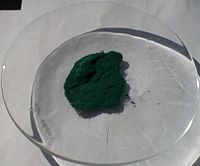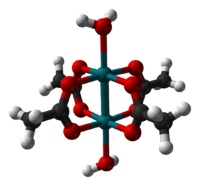- Rhodium(II) acetate
-
Rhodium (II) Acetate  Rhodium (II) acetateOther namesDirhodium tetraacetate,
Rhodium (II) acetateOther namesDirhodium tetraacetate,
Tetrakis(acetato)dirhodium(II),
Rhodium diacetate dimer,
Tetrakis-(mu-acetato)dirhodiumIdentifiers CAS number 15956-28-2 
PubChem 21674 ChemSpider 20370 
RTECS number VI9361000 Jmol-3D images Image 1 - [Rh+2].[O-]C(=O)C.[O-]C(=O)C
Properties Molecular formula C8H12O8Rh2 Molar mass 441.99 g/mol Appearance Emerald green powder Density 1.126 g/cm3 Melting point >100 °C
Boiling point decomposes
Solubility in water soluble Solubility in other solvents polar organic solvents Structure Crystal structure monoclinic Coordination
geometryoctahedral Dipole moment 0 D Hazards MSDS Coleparmer MSDS R-phrases 36/38 S-phrases 15, 26, 28A, 37/39 NFPA 704 Flash point low flammability Related compounds Related compounds Copper(II) acetate
Chromium(II) acetate acetate (verify) (what is:
acetate (verify) (what is:  /
/ ?)
?)
Except where noted otherwise, data are given for materials in their standard state (at 25 °C, 100 kPa)Infobox references Rhodium(II) acetate is the chemical compound with the formula Rh2(AcO)4, where AcO− is the acetate ion (CH3CO2−). This emerald green powder is a catalyst for cyclopropanation of alkenes. It is also used as catalyst for insertion into C-H and X-H bonds (X = N/S/O) and for ylide formation for organic syntheses.
Contents
Preparation
Rhodium(II) acetate is usually prepared by the heating hydrated rhodium(III) chloride in acetic acid (CH3COOH):[1] Rhodium(II) acetate dimer undergoes ligand exchange, the replacement of the acetate group by other carboxylates and related groups.[2]
- Rh2(OAc)4 + 4 HO2Y → Rh2(O2Y)4 + 4 HOAc
Structure and Properties
The structure of rhodium(II) acetate features a pair of rhodium atoms, each with octahedral molecular geometry, defined by four acetate oxygen atoms, a water ligand, and a Rh-Rh bond (2.39 Å.[3]. Copper(II) acetate and chromium(II) acetate adopt similar structures.
Chemical Properties
The application of dirhodium tetraacetate to organic synthesis was pioneered by Teyssie and co-workers.[4] A extensive library of successful transformations rapidly evolved, ranging from Rh(II)-catalyzed OH and NH insertions to cyclopropanation of olefins[5] and aromatic systems.[6] Nowadays, it is used mainly as a catalyst. It can help distinguish between ribonucleosides and deoxynucleosides by binding selectively to ribonucleosides at their 2' and 3' OH groups[7]. Rhodium(II) acetate dimer, compared to copper(II) acetate, is more reactive and useful in differentiating ribonucleosides and deoxynucleosides because it is soluble in aqueous solution like water whereas copper(II) acetate only dissolves in non-aqueous solution.
Selected catalytic reactions
1. Cyclopropanation

through the decomposition of diazocarbonyl compounds, the intra- and intermolecular cyclopropanation reactions occurs.
2. Aromatic cycloaddition

Rhodium acetate is a very efficient catalyst for two-component cycloaddition as well as three-component 1,3-dipolar cycloaddition reactions.
3. C-H insertion

Rh(II)-catalyzed regioselective intramolecular and regiospecific intermolecular C-H insertion into aliphatic and aromatic C-H bonds is a useful method for the synthesis of a diverse range of organic compounds.
4. Oxidation of alcohols

Allylic and benzylic alcohols were oxidized to the corresponding carbonyl compounds using tert-butyl hydroperoxide in stoichiometric amounts and Rh2(OAc)4 as catalyst in dichloromethane at ambient temperature.
5. X-H insertion (X = N/S/O)

Rh(II) carbenoid reacts with amines, alcohols or thiols to yield the product of a formal intra- or intermolecular X-H bond (X = N/O/S) insertion via the formation of an ylide intermediate.
References
- ^ Rempel, G. A.; Legzdins, P.; Smith, H.; Wilkinson, G.; Ucko, D. A. (1972). "Tetrakis (Acetato) Dirhodium (II) and Similar Carboxylato Compounds". Inorganic Syntheses. Inorganic Syntheses. 13. pp. 90. doi:10.1002/9780470132449.ch16. ISBN 9780470132449.
- ^ Doyle, M.P. (2000). "Asymmetric Addition and Insertion Reactions of Catalytically-Generated Metal Carbenes". In Ojima, Iwao. Catalytic Asymmetric Synthesis (2nd ed.). New York: Wiley. ISBN 0471298050.
- ^ Cotton, F. A.; Deboer, B. G.; Laprade, M. D.; Pipal, J. R.; Ucko, D. A. (1971). "The crystal and molecular structures of dichromium tetraacetate dihydrate and dirhodium tetraacetate dihydrate". Acta Crystallographica Section B Structural Crystallography and Crystal Chemistry 27 (8): 1664. doi:10.1107/S0567740871004527.
- ^ Paulissen, R.; Reimlinger, H.; Hayez, E.; Hubert, A. J.; Teyssié, P. (1973). "Transition metal catalysed reactions of diazocompounds - II insertion in the hydroxylic bond". Tetrahedron Letters 14 (24): 2233. doi:10.1016/S0040-4039(01)87603-6.
- ^ Hubert, A. J.; Feron, A.; Warin, R.; Teyssie, P. (1976). "Synthesis of iminoaziridines from carbodiimides and diazoesters : A new example of transition metal salt catalysed reactions of carbenes". Tetrahedron Letters 17 (16): 1317. doi:10.1016/S0040-4039(00)78050-6.
- ^ Anciaux, A. J.; Demonceau, A.; Hubert, A. J.; Noels, A. F.; Petiniot, N.; Teyssi�, P. (1980). "Catalytic control of reactions of dipoles and carbenes; an easy and efficient synthesis of cycloheptatrienes from aromatic compounds by an extension of Buchner's reaction". Journal of the Chemical Society, Chemical Communications (16): 765. doi:10.1039/C39800000765.
- ^ doi:10.1038/newbio239237a0
This DOI appears to be broken. It may be incorrect, in which case correcting it will allow the citation to be automatically completed. Or it may not be functional, in which case you can complete the citation details by hand.
Rhodium compounds Categories:- Rhodium compounds
- Acetates
Wikimedia Foundation. 2010.


